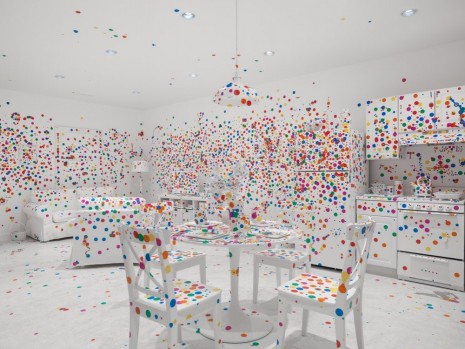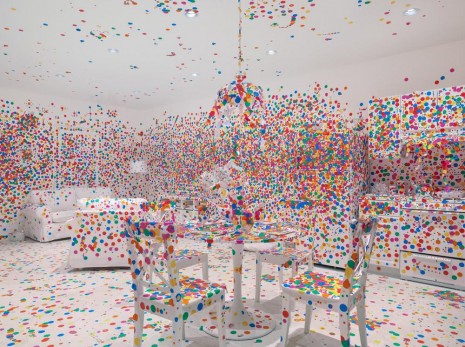Yayoi Kusama’s Obliteration Room:
Community Building in Action



Yayoi Kusama, The Obliteration Room at the David Zwirner Gallery
Give Me Love Exhibition
May 9—June 13, 2015
Alexis Shulman
Master's Thesis
American University
Art History
I would like to express my deepest appreciation to everyone who helped me with this project.
I would like to thank Dr. Ying-chen Peng, my first reader, for her feedback and generosity. I would also like to thank Dr. Nika Elder for working incredibly hard to help make sure that my arguments made sense. Thank you also to Dr. Juliet Bellow for her guidance throughout my years of both graduate and undergraduate school. I’m also extremely grateful to Dr. Andrew Wasserman for his extended support and tireless hours spent editing and critiquing my argument and for encouraging me to push my analysis further.
I would also like to thank Ms. Jacqueline Tunny for helping me find the information on The Obliteration Room directly through the QAGOMA and their commission process.
Thank you to my cohort peers who were always there to help fixed my website and writing or just to chat over dinner. I love and appreciate all of you.
Lastly, thank you to my family and my friends.
To my brother, mom, dad, step-father, and step-mother for their unwavering support during this process. I would not have been able to complete this without you all.
Shulman, Alexis. “Audience Participation in Yayoi Kusama’s Obliteration Room.” MA Thesis, American University, 2024.
Master’s Capstone Project submitted to the Faculty of the College of Arts and Sciences of American University in Partial Fulfillment of the Requirements for the Degree of Master’s of Arts in Art History.
Chair: Dr. Ying-Chen Peng
Reader: Dr. Nika Elder
Reader: Dr. Andrew Wasserman
December 15, 2024
American University, Washington DC.
This website, consisting of the capstone project by Alexis Shulman for her Master’s in Art History at American University (Washington, DC), may contain copyrighted material, the use of which may not have been specifically authorized by the copyright owner. The material contained in this website is distributed without profit for research and educational purposes.
This should constitute a ‘fair use’ of any such copyrighted material (referenced and provided for in section 107 of the US Copyright Law).
If you wish to use any copyrighted material from this site for purposes of your own that go beyond ‘fair use,’ you must obtain expressed permission from the copyright owner.
Fair Use
Copyright Disclaimer under section 107 of the Copyright Act of 1976, allowance is made for “fair use” for purposes such as criticism, comment, news reporting, teaching, scholarship, education, and research.
Fair use is a use permitted by copyright statute that might otherwise be infringing.
Fair Use Definition
Fair use is a doctrine in United States copyright law that allows limited use of copyrighted material without requiring permission from the rights holders, such as commentary, criticism, news reporting, research, teaching, or scholarship. It provides for the legal, non-licensed citation or incorporation of copyrighted material in another author’s work under a four-factor balancing test.